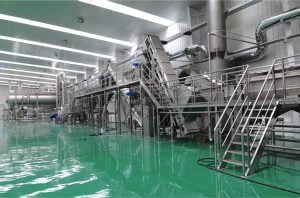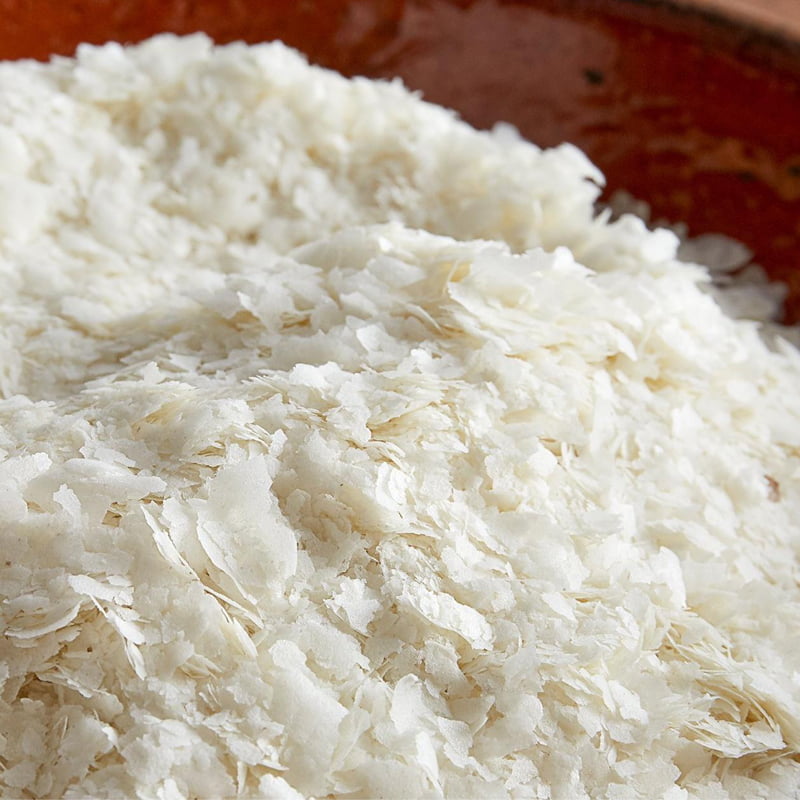Patates gevreği and potato starch are both important food additives and snack food ingredients. Fakat, many people are confused about the difference between the two. As a professional potato processing company in China, I will explain the main differences between the two in detail.

1. Difference in Properties
potato flakes are made from whole potatoes, including the skin, flesh, and fiber. It is a beige or light brown powder with a slightly potato-like flavor. Potato starch, on the other hand, is made from the starch extracted from potatoes. It is a white powder with no flavor or aroma.
2. Difference in Processing Technology
The processing of potato flakes requires more sophisticated technology. Fresh potatoes are peeled, sliced, önceden pişirilmiş, cooled, and then dried using a drum dryer.
Here is the production process:
- Raw material selection: The selection of raw materials is very important and has a direct impact on the quality of the potato flakes. Different varieties of potatoes have different dry matter content, color, depth, reducing sugar content, solanine content, and polyphenol oxidase content.
- Washing and peeling: The selected raw materials will be sent to the hopper and weighed on a belt conveyor. At the same time, they are sorted to remove potato blocks with mold spots and rotten blocks.
- Slicing: The washed and peeled potatoes will be sliced into thin slices here.
- Pre-cooking: The sliced potatoes will be pre-cooked in a steam cooker to inactivate enzymes and improve the taste and color of the finished product.
- Cooling: The pre-cooked potatoes will be cooled to room temperature here.
- Drying: The cooled potatoes will be dried in a drum dryer to a moisture content of about 8%.
- Grinding: The dried potato chips will be ground into a fine powder here.

The processing of potato starch is relatively simple. The main steps are as follows:
- Washing: The potatoes will be washed in a washing machine to remove dirt, stones, stems, and sand.
- Grinding: The washed potatoes will be ground into a slurry.
- Sieving: The potato slurry will be sieved to separate the starch milk from the waste part. The waste part is further sieved to recover some of the starch. The washed waste can be used as feed.
- Dehydration: The starch milk will dehydrated in a centrifuge to obtain potato starch.

As you can see, the processing line for potato flakes is relatively long and complex, which is why potato flake production plants are generally larger. The main energy consumption in the production process is high-temperature and high-pressure steam.
In comparison, the processing of potato starch is much simpler.

3. Differences in Raw Material Requirements
The most fundamental difference between the production of potato flakes and potato starch is the requirement for raw materials. potato flakes have high requirements for potato raw materials, while the production of starch does not have high requirements for potato raw materials.
Different Variety Requirements
The raw materials for potato flakes are processing potato varieties, mainly including Shapoty, Atlantik, and Burbank. These potato varieties have high dry matter content after maturity, large individual volume, and round shape. The production of potato starch does not have high requirements for raw materials, and there is no special requirement for potato varieties.
Different Requirements for the Size of Individual Potatoes
The production of potato flakes requires the use of large, whole potatoes, especially those weighing between 150 Ve 300 grams. The production of potato starch does not have any requirements for the size and weight of potatoes, and all potatoes can be used.
4. Different Applications of Potato Flakes and Potato Starch
Genel olarak konuşursak, potato flakes are mostly used in the production and processing of snack foods. It is the main raw material for many snack foods, such as compound potato chips. In addition, potato flakes are also used in the catering and baking industries. Furthermore, many popular flavored mashed potato products can be quickly made with potato flakes.
The application of potato starch is more extensive than potato flakes, but it is very different from the application field of potato flakes. The most common use scenario of potato starch is as a food additive and condiment. It is mainly used as an auxiliary material in the food processing field, such as meat processing, candy processing, noodle processing, and dairy product processing, and some modified starches are used in the industrial field.
5. Things You May Not Know About Potato Flakes
In our daily life, we have more contact with potato starch and have a certain understanding of its characteristics. Fakat, for potato flakes, there are some characteristics that you may not know.
- Potato flakes look like snow pieces, so it is also called potato snowflake flour. Normally, the original potato flakes are about 20 örgü, and the potato flakes manufacturers also smash them to 80 mesh for different uses.
- Potato flakes are cooked and can be eaten directly. The production process of potato flakes involves cooking so that they can be put in the mouth and eaten directly. It has a strong potato flavor.
- Potato flakes have excellent rehydration properties. Once potato flakes come into contact with water, they will quickly absorb water and turn themselves into patates püresi. If you want to make mashed potatoes at home, you can use 5 times the weight of hot water to pour into 1 times the weight of potato flakes. After about a minute, you will get a serving of mashed potato. Add your favorite seasonings and you can eat it directly. Here’s a secret: using hot milk to adjust the taste will be very good.
- Potato flakes have a very long shelf life. Because the moisture content of potato flakes is very low, it can be guaranteed to not deteriorate for many years after being sealed and stored. Despite this, I still recommend that everyone eat freshly produced products.
Other Things About Potato Flakes and Potato Starch
In the production of potato flakes and starch, because of the different requirements for raw materials, better potatoes are often used to produce potato flakes, while the screened potatoes are used to produce starch.
Also based on the different requirements for raw materials, the price of potato flakes will fluctuate more than potato starch’s. In food production, when the production cost of potato starch is too high, there will be other types of starch to replace potato starch, while potato flakes have almost no alternative products.
When you directly eat mashed potatoes made from potato flakes, you may feel a little raw taste. That is because although potato flakes are a cooked product, the cooking degree has not reached 100%. Genel olarak konuşursak, the cooking degree is 80%, but it has no effect.
About the Author
Martin Wong
Martin Wong is the Sales Director of Xion Biological. He has worked in the potato deep processing industry for more than ten years and has a deep understanding of potato processing and products. He hopes to communicate and discuss all potato-related issues with readers.
